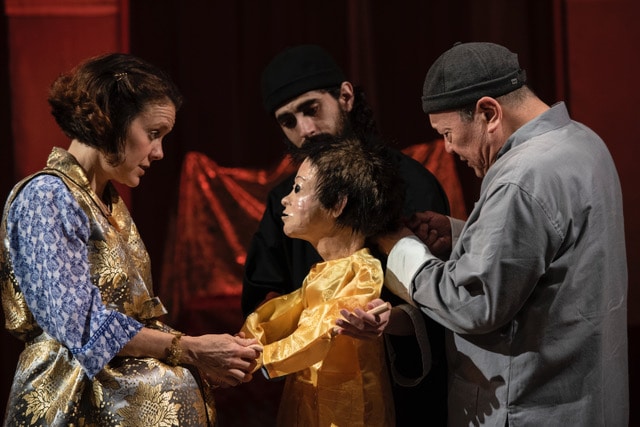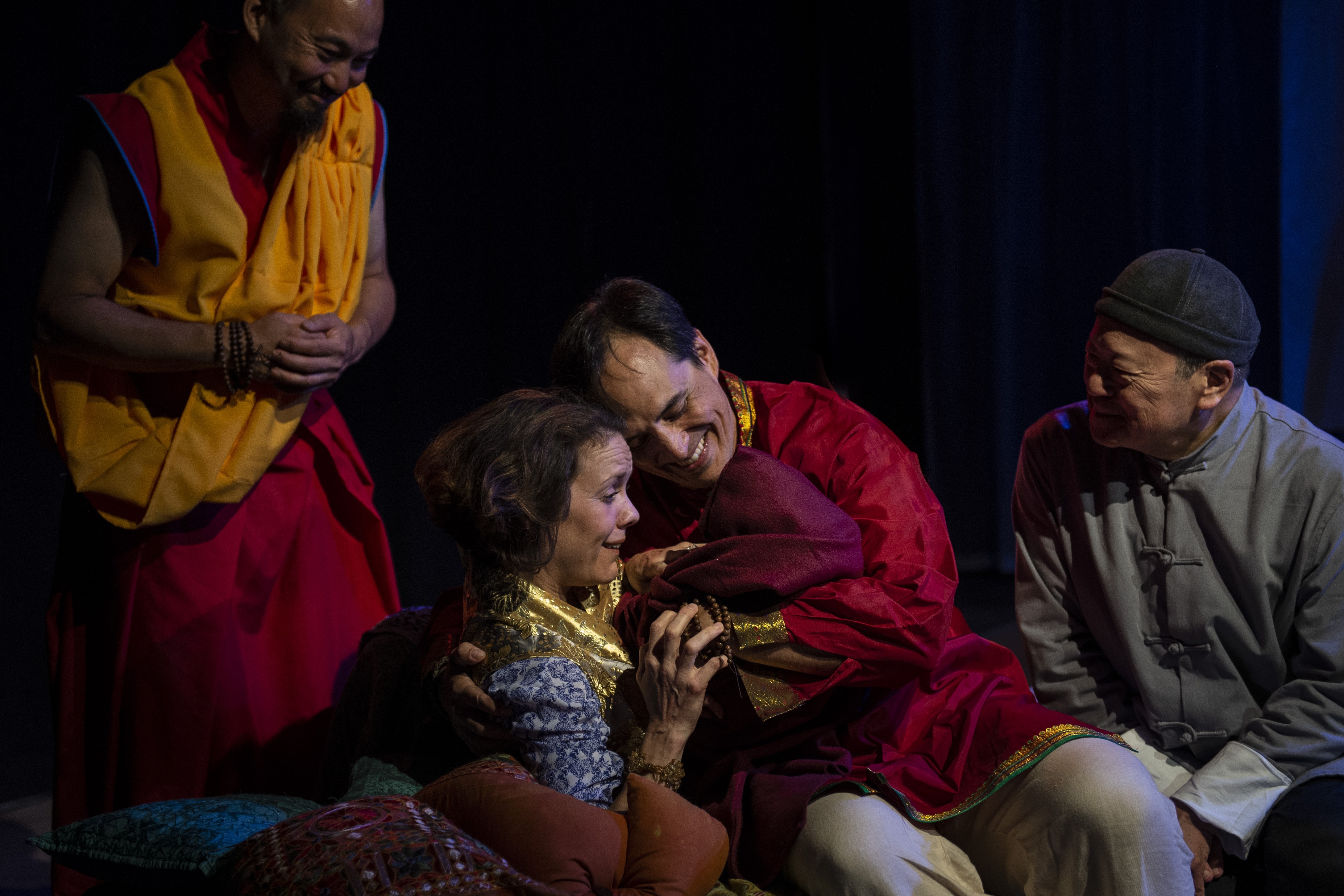Sara Ruhl’s The Oldest Boy tells a gut-wrenching story serenely, almost gently. At the heart of it is the bond between mother and child, a tie that Ruhl knew intimately when she wrote the play, shortly after she herself gave birth. In The Oldest Boy, she creates a dramatic correlative for her own mixed feelings of maternal attachment and anticipated separation—and strikingly she sets this very personal young mother’s story in a context she knew from research not first-hand: the world of Tibetan Buddhism.
An unnamed character identified in the program as Mother (Jenna Sokolowski), who is American, is married to Father (Rafael Untalan), who is Tibetan. They have a three-year-old son named Tenzin, the titular Oldest Boy, who is depicted as a puppet (voiced by Al Twanmo). One day Mother and Father are visited by Monk (Franklin Dam) and Lama (Steve Lee), who inform them that their son is a reincarnated lama and so must be taken to India to be raised and taught in an all-male monastery. The central conflict in the play thus becomes whether Mother and Father can let the boy go and make peace with having done so.

The production directed by Kathryn Chase Bryer at Spooky Action Theater is lovely to look at and listen to—its stunning ceremonial evocations of Tibetan Buddhism in music, movement, and design lend a reverent aura of authenticity that transports us to a captivating world of ritual and faith (for this much credit goes to Movement Director and Music and Cultural Consultant Tuyet Thi Pham). And in addition to Sokolowski’s frequently heartwrenching performance as Mother-facing-separation-from-her child, the actors in the four Tibetan roles (Dam, Lee, Twanmo, and Untalan) inspire a sense that a seemingly surreal story is being told truthfully.
Improbably but enchantingly, the Oldest Boy puppet (constructed by Matthew Pauli) resembles not at all a rambunctious, whiny toddler but rather a child wise beyond his years, a wide-eyed small person with an unchanging expression of knowingness and composure—as though he was born that way.
Whatever one may believe about reincarnation, Ruhl’s script is cleverly persuasive that this puppet boy really is the embodied return of Lama’s revered teacher, who died just before Tenzin was born. Theater can play tricks like that, so we willingly play along. Further, we are given to understand that the boy will be exceedingly well taken care of by nurturant and worshipful monks, and his parents can visit on weekends. Thus what could be a sorrow-filled story of loss (bordering on child-snatching) is magically melded to a beatific story of distinction (bordering on glory). And in the tension between, Ruhl leaves us uncertain whether we are to feel the distress of bereft parents trying to reconcile themselves to an impending separation or whether we are to accept gracefully a plot point that as framed in the play is the boy’s divine destiny.
And then about midway through, the Mother asks a rhetorical question that cracks apart the whole predicament…
MOTHER: Why does every religion have stories about giving up your child?
I’m not sure if Ruhl meant that line to take us out of the play, to go all meta on what is going on, but it does, especially as Mother starts citing the Bible…
MOTHER: I always thought the Abraham story was so awful…. God comes down and says, “Abraham, kill your son to prove your faith in me.” And so Abraham puts his son on a slab of rock and is about to stab him and God says, “What are you doing, Abraham, I was just kidding!”
And there’s more scriptural sourcing. Mother has a separation nightmare, a version of the Solomonic parable about the child claimed by two mothers. In her dream, it is Lama tugging at one of the puppet boy’s arms and she herself tugging the other—so hard she tears off the child’s arm.
Other religious stories on the theme come to mind: Mary venerated for letting the fruit of her womb go off to temple when he was barely twelve. Hannah venerated for turning her son Samuel over to priests when he was barely weaned. Funny how the sanctified menfolk required in the practice of patriarchal religions seem all to have been ripped untimely from womenfolks’ wombs. I’m not sure it was Ruhl’s intent to reflect on that fact, but The Oldest Boy sure puts the issue front and center, for instance when Father touts this patriarchal party line:
FATHER: Our son was chosen not just for himself, but to benefit others. You must think bigger than being only a mother.
MOTHER: Only a mother? He came out of my body.
Mother doesn’t have to wail the words to convey her indignation at the dis.

As the second act of The Oldest Boy begins, Mother and Father are in India for what will be their ceremonial farewell to Tenzin, and Mother is again pregnant. Dramaturgically this conception is convenient, almost pat: it reassures us they will have a spare as they’re about to lose an heir. But the zinger Ruhl delivers comes in a gender reveal. Mother tells Father she feels something, knows something. About to lose a son to a sanctum of men—a near universal in the lives of mothers—she has a profeminist premonition that brings her passing peace:
MOTHER: It’s a girl. It has to be. If she’s a girl, she can’t be a lama.
[Read Sophia Howes’s review of The Oldest Boy.]
Running Time: About two hours, including one intermission.
The Oldest Boy: A Play in Three Ceremonies plays through June 30, 2019, at Spooky Action Theater – 1810 16th St NW, in Washington, DC. Purchase tickets online, by phone (202) 248-0301, or at the theater one hour before performances.




